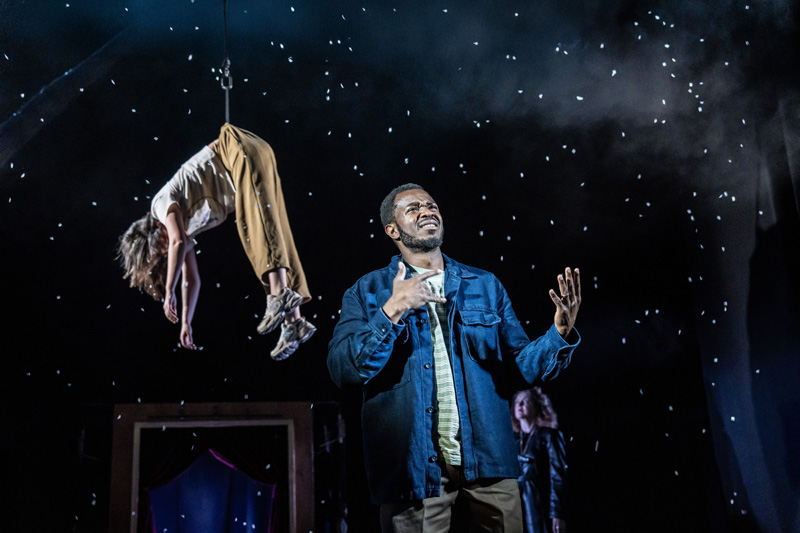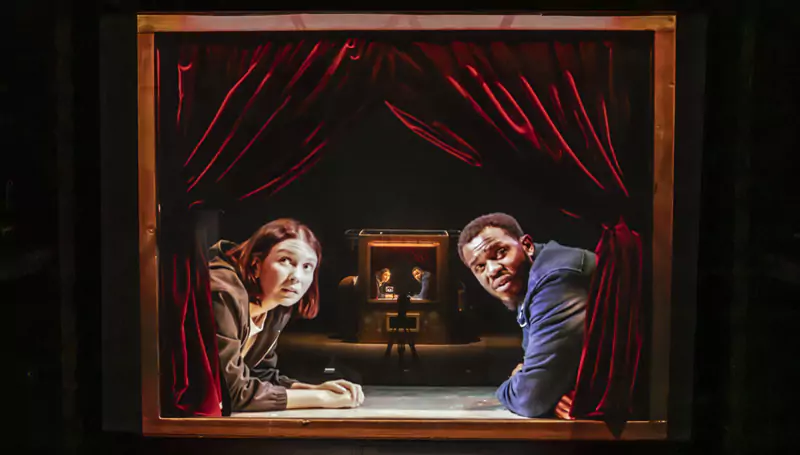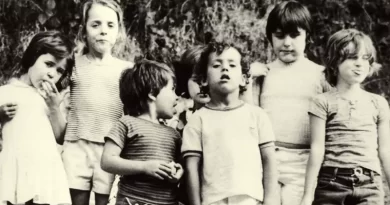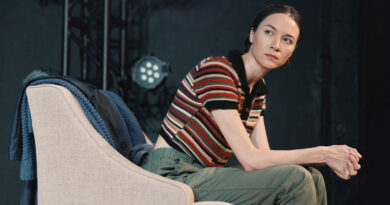“Deaf Republic” at Royal Court Theatre Downstairs
Jeremy Malies in West London
7 September 2025
★★
Occupying soldiers in an Eastern European country shoot dead a deaf boy who could not hear their orders. The whole town of Vasenka is struck deaf or feigns deafness in defiance. I was reminded of Ionesco’s Rhinoceros but (putting it crudely) with the political polarity reversed.

Romel Belcher.
Photography credit: Johan Persson.
Using theatre to prompt the hearing community into confronting their possible misunderstanding of deafness as a disability or deafness as a culture is surely a solemn undertaking. Throw in discussion of the current war in Ukraine and the stakes become even higher.
Dublin-based theatre company Dead Centre have adapted a 2019 set of lyric poems (also assembled as a play) by Odesa-born Ilya Kaminsky. No fewer than three writers (Bush Moukarzel, Ben Kidd, and Zoë McWhinney) are credited in the programme with McWhinney being the lead adaptor. And therein lies the problem.
I’ve absorbed the fact that the project seeks to make us think about the many ways in which we can express ideas through theatre, and it’s therefore legitimate to represent various forms including puppetry of many kinds as well as video projection. I understand that Kaminsky’s signature methods involve parables and parallel realities. And yet, despite moments of lyricism and a wonderful fight scene choreographed by Ciaran O’Grady, the project lacks focus and often sinks under its own weight.
The main actors are Caoimhe Coburn Gray and Romel Belcher. They play a pair of lovers who run a puppet theatre in Vasenka. In a clever opening scene (the piece never recaptures the early insight and disarming wit) Belcher explains their background and prompts us to think about inclusiveness and accessibility. In a neat piece of inversion, Coburn Gray is a “worder” who gives the hearing audience members a version of what Belcher is telling us in British Sign Language.
As their real selves rather than the characters, the pair discuss Coburn Gray’s frustration at simply relaying the thoughts of others without truly contributing. There is inspired discussion of the dynamic nature of sign language; how ideas flash through sequences rather than being static as a single word, and how signs can vary according to the user. “Colonialism” for a Black person is signed with the sense of something being surrendered unwillingly. For a white person, it is a sign of something being taken. A bleak outlook but revealing.
In Jeremy Herbert’s detailed and fluid set, the couple’s puppet theatre becomes a nested sequence. We move between a standard Punch and Judy set-up that you might find at the seaside to a doll’s house theatre higher up the stage.
In Moukarzel and Kidd’s production, the strands don’t coalesce, and the play descends into agitprop. A stated aim in the programme is to discuss how deafness might be used for political leverage to resist violent oppression. But the Ukrainian element feels tacked on when in fact, through the work of the non-governmental Social Unity project, the record of Ukraine in Deaf advocacy since 2015 has been good.
There is a phase of the play when lead writer McWhinney clearly thinks that she should be Brechtian for a while. This falls to Derbhle Crotty who plays Galya, a self-confident gobby townswoman in Vasenka. But things almost creak as Crotty, finding no modulation in voice or gesture, goes through Mother Courage (world-weary reflections on the conflict), The Caucasian Chalk Circle (a child needing protection), and even Oh, What a Lovely War! with a strutting end-of-the pier quality accompanied by Pierrot clowns.
Despite these excesses and even show-off qualities, there is a lot that is thought-provoking. The central idea that being a hearing person might be the atypical experience is profound. But if we are to have various kinds of puppetry and aerial movement, do we really need live video as well? The camerawork (video direction by Grant Gee) involves both sweeping shots and extreme close-up as McWhinney toys with our sense of scale and perspective.
The vertical movement is excellent; aerial consultants Chrissie Ardill and Kat Cooley have characters winched up from the stage and dropped back down with the movements being slick and integrated into the plot. The idea is that everybody is on a string of some kind. But I felt the story could have been propelled better with fewer elements, and clarity suffered amid all the modes.
The introduction of both actual puppets and realistic (no doubt artificial intelligence enhanced) video replications of those puppets struck me as unnecessary and even lazy. And none of this chimed with my usual idea of puppetry as a pure and stripped-back mode of theatre. Kaminsky’s narrative in the original poems (mercifully we don’t have the extra theme of interventionist action by the United States) could have been given more room to breathe.
The play is bookended by Alfonso (the Belcher character) pleading urgently for empathy. We should go to the theatre to understand each other. You could hardly disagree with that, but despite the moments of beauty, deep understanding and virtuosity by the creative team, there is too much going on here with the piece pushing at a profusion of genres. The writing is preachy, over-reliant on advanced technical forms, and does not propel the core activism well.









